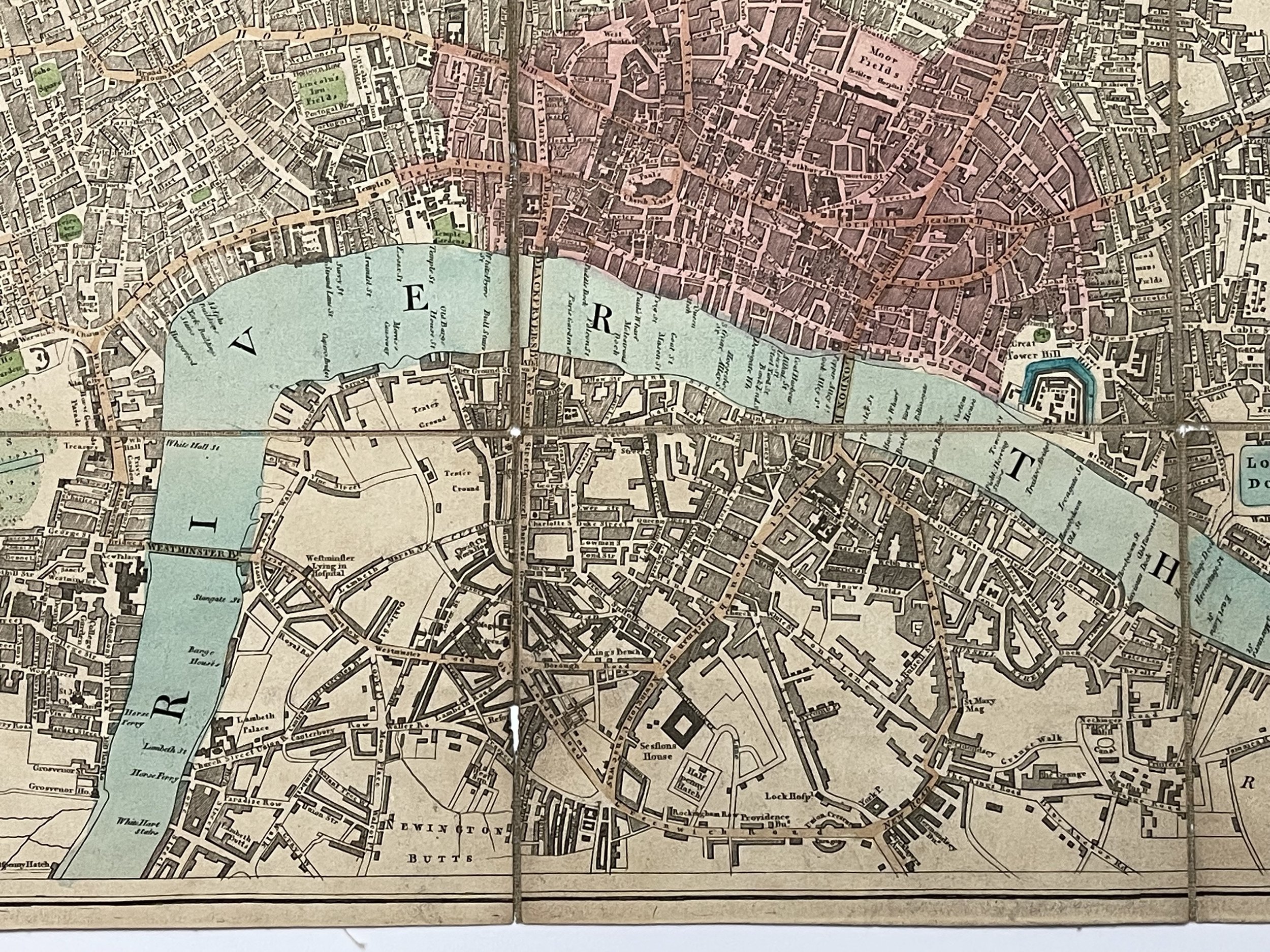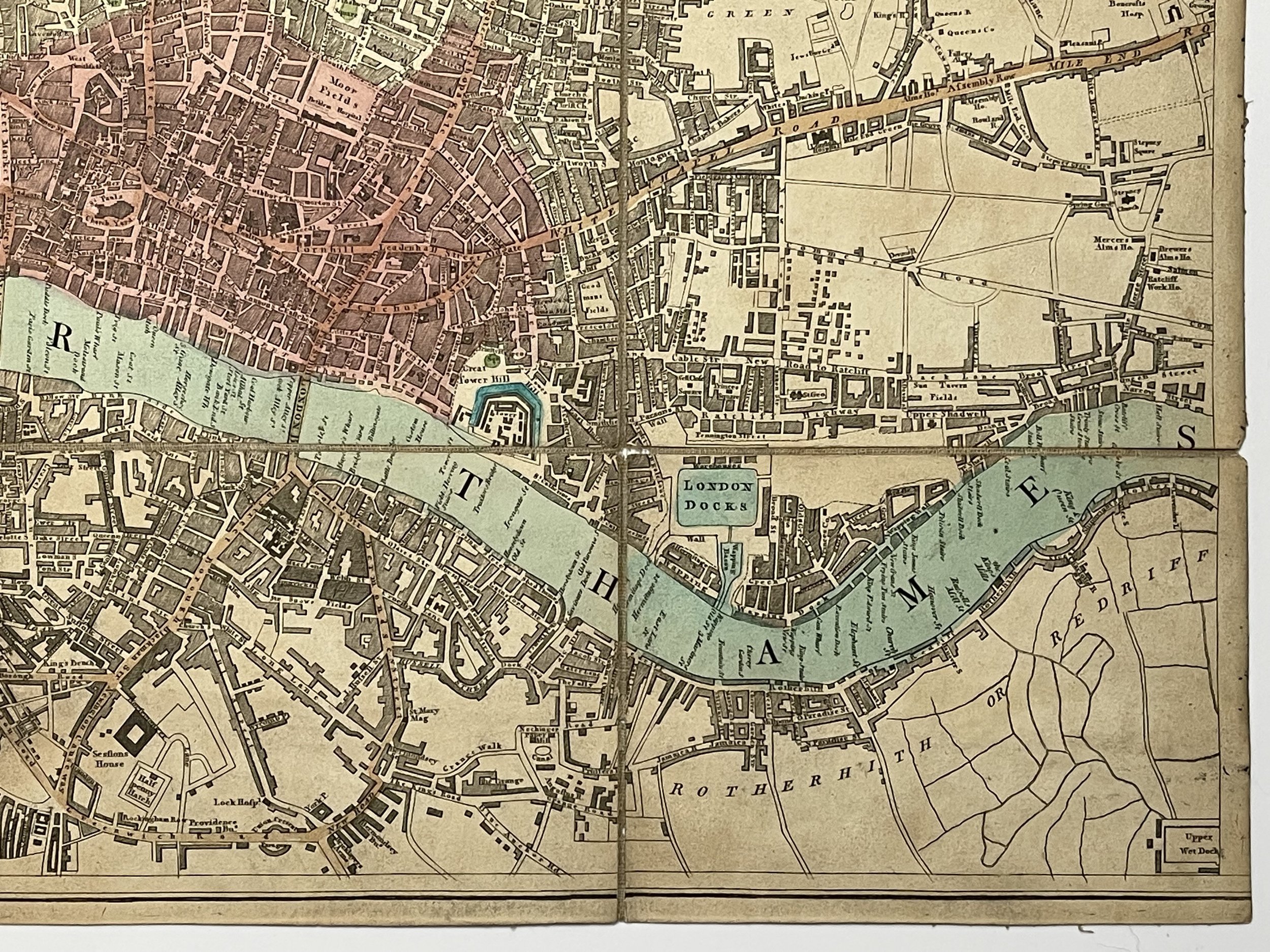New Plan of the Cities of London Westminster - Thomas Tegg - Dated Jan 20th 1812
Scarce - New Plan of the Cities of London Westminster - the Borough of Southwark, including all the public buildings, squares & C.- Thomas Tegg - Dated Jan 20th 1812 (for the 1813 edition). Published during Teggs tenure at 111 Cheapside, London.
Thomas Tegg (1776–1845) was a British bookseller and publisher.
Was the son of a grocer, born at Wimbledon, Surrey, on 4 March 1776, and was left an orphan at the age of five. He was sent to a boarding school at Galashiels in Selkirkshire. In 1785 he was bound apprentice to Alexander Meggett, a bookseller at Dalkeith. He ran away, sold chapbooks at Berwick, and spent time at Newcastle where he met the wood engraver Thomas Bewick. In Sheffield he obtained employment from Joseph Gales, the proprietor of the Sheffield Register, and encountered Tom Paine and Charles Dibdin. Further wanderings took him to Ireland and Wales, and then, after some years at King's Lynn in Norfolk, he moved to London in 1796. In London he obtained an engagement with William Lane, the proprietor of the Minerva Library, at 53 Leadenhall Street. He subsequently worked for John and Arthur Arch, the Quaker booksellers of Gracechurch Street, where he stayed until he began business on his own account.
Tegg took a shop in partnership with Joseph Dalton Dewick in Aldersgate Street. On 20 April 1800 he married, and opened a shop in St. John Street, Clerkenwell, but lost money through the bad faith of a friend. He took out a country auction licence to try his fortune in the provinces. He started with a stock of shilling political pamphlets and some thousands of the Monthly Visitor. With his wife acting as clerk, he travelled and bought up duplicates in private libraries, clearing his debts.
Returning to London in 1805, he opened a shop at 111 Cheapside. He printed a series of pamphlets, consisting of abridgements of popular works. They proved successful, and he had up to two hundred titles, many of which sold four thousand copies. By 1840 he had published four thousand works on his own account. The Whole Life of Nelson, which he brought out just after the battle of Trafalgar in 1805, sold fifty thousand copies at 6d. and the Life of Mary Anne Clarke (1810), thirteen thousand copies at 7s. 5d. each. In 1824 he purchased the copyright of William Hone's Everyday Book and Table Book, and, republishing it in weekly parts, made a large profit. He then gave Hone £500 to write The Yearbook, which proved less successful.
When his own publications began paying well, he gave up auctions, which he had continued nightly at 111 Cheapside. In 1824 he made his final move, to 73 Cheapside. In 1825 he started the London Encyclopaedia which ran to twenty-two volumes. He bought remainders on a large scale. He was mentioned as a populariser of literature in Thomas Carlyle's petition on the copyright bill in April 1839.
In 1835, being then a common councilman of the ward of Cheap, he was nominated an alderman but was not elected. In 1836 he was chosen Sheriff of London; he paid the conventional fine to escape serving, of £400, and added another £100, founding a Tegg scholarship at the City of London School and donating a collection of books.
He died on 21 April 1845 and was buried at Wimbledon. He was generally believed to have been the original of Timothy Twigg in Thomas Hood's 1834 novel Tylney Hall. Tegg left three sons, including Thomas Tegg, a bookseller, who died on 15 September 1871 and William (1816–1895), who continued the business.
Scarce example in Beautiful condition for its age, complete with slipcase. Pricing and grading commensurate.
Scarce - New Plan of the Cities of London Westminster - the Borough of Southwark, including all the public buildings, squares & C.- Thomas Tegg - Dated Jan 20th 1812 (for the 1813 edition). Published during Teggs tenure at 111 Cheapside, London.
Thomas Tegg (1776–1845) was a British bookseller and publisher.
Was the son of a grocer, born at Wimbledon, Surrey, on 4 March 1776, and was left an orphan at the age of five. He was sent to a boarding school at Galashiels in Selkirkshire. In 1785 he was bound apprentice to Alexander Meggett, a bookseller at Dalkeith. He ran away, sold chapbooks at Berwick, and spent time at Newcastle where he met the wood engraver Thomas Bewick. In Sheffield he obtained employment from Joseph Gales, the proprietor of the Sheffield Register, and encountered Tom Paine and Charles Dibdin. Further wanderings took him to Ireland and Wales, and then, after some years at King's Lynn in Norfolk, he moved to London in 1796. In London he obtained an engagement with William Lane, the proprietor of the Minerva Library, at 53 Leadenhall Street. He subsequently worked for John and Arthur Arch, the Quaker booksellers of Gracechurch Street, where he stayed until he began business on his own account.
Tegg took a shop in partnership with Joseph Dalton Dewick in Aldersgate Street. On 20 April 1800 he married, and opened a shop in St. John Street, Clerkenwell, but lost money through the bad faith of a friend. He took out a country auction licence to try his fortune in the provinces. He started with a stock of shilling political pamphlets and some thousands of the Monthly Visitor. With his wife acting as clerk, he travelled and bought up duplicates in private libraries, clearing his debts.
Returning to London in 1805, he opened a shop at 111 Cheapside. He printed a series of pamphlets, consisting of abridgements of popular works. They proved successful, and he had up to two hundred titles, many of which sold four thousand copies. By 1840 he had published four thousand works on his own account. The Whole Life of Nelson, which he brought out just after the battle of Trafalgar in 1805, sold fifty thousand copies at 6d. and the Life of Mary Anne Clarke (1810), thirteen thousand copies at 7s. 5d. each. In 1824 he purchased the copyright of William Hone's Everyday Book and Table Book, and, republishing it in weekly parts, made a large profit. He then gave Hone £500 to write The Yearbook, which proved less successful.
When his own publications began paying well, he gave up auctions, which he had continued nightly at 111 Cheapside. In 1824 he made his final move, to 73 Cheapside. In 1825 he started the London Encyclopaedia which ran to twenty-two volumes. He bought remainders on a large scale. He was mentioned as a populariser of literature in Thomas Carlyle's petition on the copyright bill in April 1839.
In 1835, being then a common councilman of the ward of Cheap, he was nominated an alderman but was not elected. In 1836 he was chosen Sheriff of London; he paid the conventional fine to escape serving, of £400, and added another £100, founding a Tegg scholarship at the City of London School and donating a collection of books.
He died on 21 April 1845 and was buried at Wimbledon. He was generally believed to have been the original of Timothy Twigg in Thomas Hood's 1834 novel Tylney Hall. Tegg left three sons, including Thomas Tegg, a bookseller, who died on 15 September 1871 and William (1816–1895), who continued the business.
Scarce example in Beautiful condition for its age, complete with slipcase. Pricing and grading commensurate.
Scarce - New Plan of the Cities of London Westminster - the Borough of Southwark, including all the public buildings, squares & C.- Thomas Tegg - Dated Jan 20th 1812 (for the 1813 edition). Published during Teggs tenure at 111 Cheapside, London.
Thomas Tegg (1776–1845) was a British bookseller and publisher.
Was the son of a grocer, born at Wimbledon, Surrey, on 4 March 1776, and was left an orphan at the age of five. He was sent to a boarding school at Galashiels in Selkirkshire. In 1785 he was bound apprentice to Alexander Meggett, a bookseller at Dalkeith. He ran away, sold chapbooks at Berwick, and spent time at Newcastle where he met the wood engraver Thomas Bewick. In Sheffield he obtained employment from Joseph Gales, the proprietor of the Sheffield Register, and encountered Tom Paine and Charles Dibdin. Further wanderings took him to Ireland and Wales, and then, after some years at King's Lynn in Norfolk, he moved to London in 1796. In London he obtained an engagement with William Lane, the proprietor of the Minerva Library, at 53 Leadenhall Street. He subsequently worked for John and Arthur Arch, the Quaker booksellers of Gracechurch Street, where he stayed until he began business on his own account.
Tegg took a shop in partnership with Joseph Dalton Dewick in Aldersgate Street. On 20 April 1800 he married, and opened a shop in St. John Street, Clerkenwell, but lost money through the bad faith of a friend. He took out a country auction licence to try his fortune in the provinces. He started with a stock of shilling political pamphlets and some thousands of the Monthly Visitor. With his wife acting as clerk, he travelled and bought up duplicates in private libraries, clearing his debts.
Returning to London in 1805, he opened a shop at 111 Cheapside. He printed a series of pamphlets, consisting of abridgements of popular works. They proved successful, and he had up to two hundred titles, many of which sold four thousand copies. By 1840 he had published four thousand works on his own account. The Whole Life of Nelson, which he brought out just after the battle of Trafalgar in 1805, sold fifty thousand copies at 6d. and the Life of Mary Anne Clarke (1810), thirteen thousand copies at 7s. 5d. each. In 1824 he purchased the copyright of William Hone's Everyday Book and Table Book, and, republishing it in weekly parts, made a large profit. He then gave Hone £500 to write The Yearbook, which proved less successful.
When his own publications began paying well, he gave up auctions, which he had continued nightly at 111 Cheapside. In 1824 he made his final move, to 73 Cheapside. In 1825 he started the London Encyclopaedia which ran to twenty-two volumes. He bought remainders on a large scale. He was mentioned as a populariser of literature in Thomas Carlyle's petition on the copyright bill in April 1839.
In 1835, being then a common councilman of the ward of Cheap, he was nominated an alderman but was not elected. In 1836 he was chosen Sheriff of London; he paid the conventional fine to escape serving, of £400, and added another £100, founding a Tegg scholarship at the City of London School and donating a collection of books.
He died on 21 April 1845 and was buried at Wimbledon. He was generally believed to have been the original of Timothy Twigg in Thomas Hood's 1834 novel Tylney Hall. Tegg left three sons, including Thomas Tegg, a bookseller, who died on 15 September 1871 and William (1816–1895), who continued the business.
Scarce example in Beautiful condition for its age, complete with slipcase. Pricing and grading commensurate.
Code : A1103
Cartographer : Cartographer / Engraver / Publisher: Thomas Tegg
Date : Publication Place / Dated - 3rd September 1812
Size : Sheet size: Upon application.
Availability : Available
Type - Genuine - Antique
Grading A
Where Applicable - Folds as issued. Light box photo shows the folio leaf centre margin hinge ‘glue’, this is not visible otherwise.
Tracked postage, in casement. Please contact me for postal quotation outside of the UK.

















